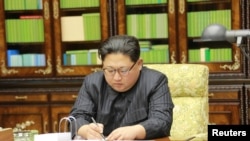The United States and South Korean air forces are holding one of their largest ever joint exercises.
The five days of exercises are named Vigilant ACE. South Korean troops are training with more than 230 airplanes and 12,000 members of the U.S. armed forces.
The planes include a number of U.S. stealth warplanes. The high-technology aircraft are designed to avoid discovery by radar.
The exercises began less than one week after North Korea tested its most advanced long-distance missile. The North Korean government said it launched an intercontinental ballistic missile, or ICBM, last Tuesday. The Hwasong-15 rocket traveled farther than any of the country’s earlier rockets.
New missile approaches “red line?”
The new rocket was said to be able to reach anywhere in the United States.
However, experts are wondering whether the missile is ready to carry a nuclear weapon. Some say the North needs months or years before it can develop a missile equipped to carry a warhead to a target without burning up.
South Korea has yet to confirm that the Hwasong-15 missile successfully reentered the atmosphere.
South Korea’s Unification Ministry spokesman Baik Tae-hyun told reporters Monday that, “We are making efforts to resolve the North’s nuclear issue peacefully with the international community.” But he added, “The government does not accept the North’s ‘unilateral’ claim to completing its nuclear program.”
In July, South Korean President Moon Jae-in said that North Korea’s possession of a fully operational ICBM would represent a “red line” for possible military action.
U.S. officials have warned that they will not let North Korea threaten the South with a nuclear missile.
The North Korean government denounced the military exercises this week. The country has long said that such activities are preparations for an attack. North Korea’s state-operated Korean Central News Agency warned that the United States was driving the Korean peninsula to the “brink of war.”
This weekend, U.S. officials voiced concerns about the intensity of tensions.
H.R. McMaster serves as National Security Advisor to President Donald Trump. McMaster said on Saturday that the chance of war with North Korea is “increasing with every day.”
Also, Senator Linsey Graham of South Carolina called on the U.S. Defense Department to remove the families of armed forces members from South Korea. Graham is a member of Trump’s Republican Party.
The president has threatened to act against North Korea if it attacks the United States or its allies.
In November, the U.S. government again placed North Korea on its state sponsors of terrorism list. That move permits adding to already highly restrictive trade sanctions against the North.
Ralph Cossa is president of Pacific Forum CSIS, a private, foreign policy research center. He said that military action, with its deadly results for South Korea, is only one idea for answering the North’s tests.
“Red line responses don’t have to be military but they should be significant and painful politically and economically, if not militarily,” said Cossa. He added, “They are also most effective if spelled out in advance and then acted upon.”
However, the Defense Department has said the North’s tests are not yet a threat to the United States' mainland. The government has set up missile defense systems in South Korea and Guam, as well as the states of Alaska and California, in an effort to protect the U.S. and its allies.
After launch, future of talks unclear
North Korea’s neighbors, China and Russia, have supported a plan called “dual suspension.” Under the proposal, the United States and South Korea would halt military exercises in exchange for North Korea stopping its weapons programs.
China’s Foreign Minister Wang Yi said the two months in which North Korea did not test a missile had not been effectively used for diplomacy. He said that the parties involved in tensions on the Korean peninsula had not “grasped the window of opportunity.”
Ralph Cossa of the Honolulu-based Pacific Forum CSIS said that additional restrictions are likely.
“The U.S. seems to be warning that it will seek ship inspections and more intrusive maritime measures, but it is unclear Beijing and Moscow will go along,” he said.
Other observers say another possibility is that North Korea’s declaration of having “completed” its nuclear program may signal a change. They say the North Korean leadership may want to improve the country’s economy instead of continued weapons testing.
The United Nations has said that one of its officials will visit North Korea for the first time since 2011.
UN Under-Secretary-General for Political Affairs Jeffrey Feltman is expected to visit the North’s capital, Pyongyang this week.
Feltman is expected to meet with North Korea’s Foreign Minister and Vice-foreign Minister.
A UN spokesman talks will include “wide-ranging policy discussions.”
I’m Mario Ritter.
Daniel Schearf reported this story for VOA News. Mario Ritter adapted his report for Learning English. George Grow was the editor.
_______________________________________________________________
Words in This Story
vigilance – n. the state of being watchful
advanced – adj. modern, highly developed
unilateral – adj. involving only one side or group
brink – n. the edge
sponsors – n. those who support a person, group or activity
sanctions – n. actions, usually to limit trade, that are meant to cause a country to obey international rules
grasp – v. to take hold of
maritime – adj. of or related to the sea
We want to hear from you. Write to us in the Comments section, and visit our Facebook page.











